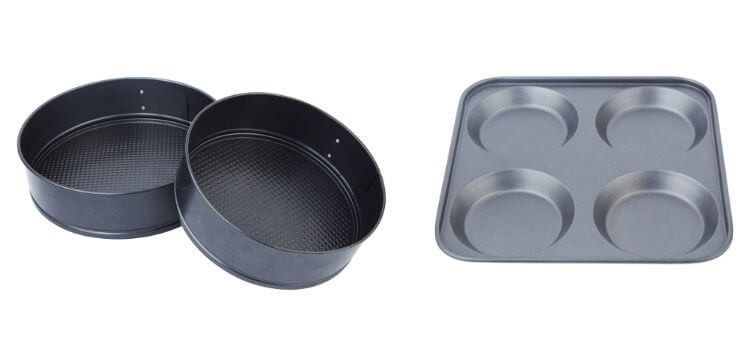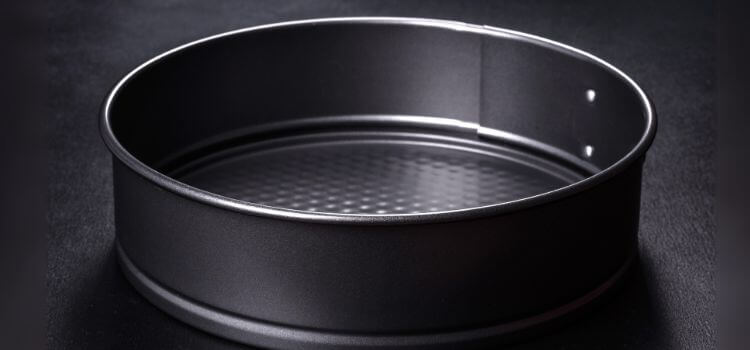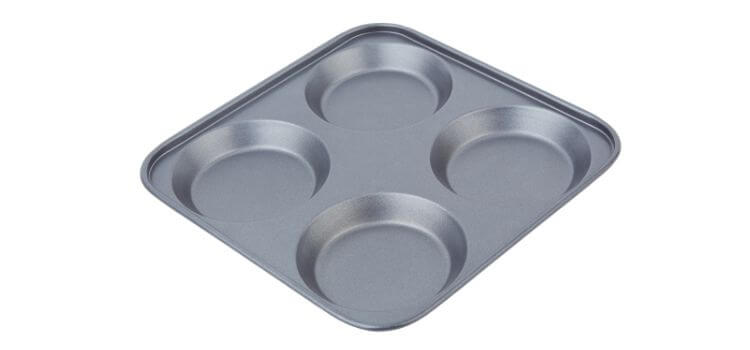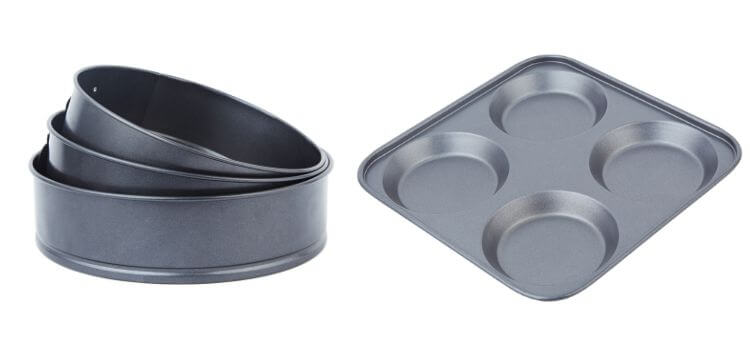As an Amazon Associate, I earn from qualifying purchases

When baking delicious desserts, choosing between a cake pan and a pie pan can significantly impact the outcome of your culinary creations. Each pan type has unique characteristics that can influence the texture, shape, and overall presentation of your baked goods.
In this article, we delve into the differences between cake and pie pans, exploring their uses, benefits, and how to select the right pan for your baking adventures. Whether you’re a seasoned baker or just starting in the kitchen, understanding the nuances of these essential tools is key to mastering the art of baking.
What is a Cake Pan

A cake pan is a round or square-shaped baking pan with shallow, straight sides and no fluted edges. It can be crafted from a variety of materials, including aluminum, stainless steel, glass, ceramic etc. The most common size for a cake pan is 9 inches in diameter.
The key characteristic of a cake pan is its depth, which allows the batter to rise and create a fluffy and light-textured cake. The lack of fluted edges makes removing the cake from the pan easier without compromising its shape.
Types of cake pans
Aside from the standard round and square-shaped cake pans, other types are also available. Bundt pans, for example, have a distinctive fluted design that adds an elegant touch to cakes. These pans are typically used for dense and rich cakes like pound cakes and Bundt cakes.
Springform cake pans have a removable bottom and sides that can be unclipped, making it easier to release delicate cakes such as cheesecakes without damaging them. Another popular type is the sheet cake pan, a large rectangular pan used for baking single-layer or sheet cakes.
Benefits of using a cake pan
Using a cake pan for baking has several benefits, including:
- Even heat distribution: A cake pan’s shallow and straight sides allow for even heat distribution, resulting in consistent baking.
- Versatility: Cake pans come in various sizes and shapes, making them versatile for different cakes.
- Ease of serving: The smooth edges and removable bottom (in some cases) make it easier to release the cake from the pan and serve it without ruining its shape.
- Easy clean-up: The majority of cake pans are designed to be dishwasher safe, ensuring that clean-up is effortlessly simple.
What is a Pie Pan

A pie pan, dish, or plate is designed specifically for baking pies. Its fluted edges create the classic round shape of a pie and can be made of ceramic, glass, metal, or stoneware.
Pie pans come in various sizes, with 9 inches being the standard size for most recipes. They also come in different depths, depending on the type of pie you’re baking. For example, a deep-dish pie pan is best for making fruit pies with lots of filling.
Types of pie pans
Pie pans can be made of various materials, each with its benefits and drawbacks:
- Glass: Glass pie pans are popular because they allow you to see the bottom crust and ensure it’s evenly cooked. However, they can shatter under high heat or drastic temperature changes.
- Metal: Metal pie pans, usually made of aluminum or steel, are durable and conduct heat well, resulting in evenly baked pies. However, they can cause the crust to become too brown or even burn if not monitored carefully.
- Ceramic: Ceramic pie pans are aesthetically pleasing and retain heat well, resulting in a crispy bottom crust. They are available in a range of colors and designs, making them ideal for presentation purposes. However, they can be heavy and more prone to cracking or breaking.
Benefits of using a pie pan
Some advantages of using a pie pan for baking include:
- Perfect crust: The fluted edges of a pie pan create the iconic shape of a pie, making it visually appealing.
- Great for juicy fillings: The depth of a pie pan allows for ample filling, making it perfect for juicy pies like fruit or custard.
- Variety of crust options: Depending on the pie you’re making, you can choose from different crust options like traditional pastry, graham cracker, or cookie crust.
A Comparison: Cake Pan vs Pie Pan

At first glance, cake and pie pans might appear similar, yet they possess unique traits that distinguish them from one another.
- Depth: As mentioned earlier, the depth of a cake pan allows the batter to rise and create a fluffy cake, while the depth of a pie pan accommodates filling.
- Edges: The straight edges of a cake pan are ideal for creating even layers, while the fluted edges of a pie pan add to its visual appeal.
- Material: Cake pans are often made of lightweight materials like aluminum or silicone, while pie pans tend to be heavier and sturdier due to the weight of the filling.
The choice between a cake pan and a pie pan can significantly impact the outcome of your baked goods. Here are some examples:
- Texture: Using a deeper pie pan for baking a cake may result in a denser texture due to the lack of space for the batter to rise.
- Shape: A shallow pie dish may cause excess filling to spill over, resulting in a messy and uneven pie.
- Crust: The pan’s material can affect the crust’s texture and color, with glass pans resulting in a crispier bottom crust than metal or ceramic pans.
Selecting the Right Pan: Cake Pan vs Pie Pan
Factors to consider:
- Type of dessert: As discussed, certain desserts like cakes and pies require specific pans. Consider the recipe you’re using and choose accordingly.
- Size and shape: The size and shape of your pan can affect the baking time and result in differently textured or shaped desserts. For optimal results, carefully adhere to the recipe’s directions.
- Material: Different materials have their benefits and drawbacks. Consider which qualities are most important to you when making your decision.
- Occasion or presentation: If you’re baking for a special occasion or want to present your dessert aesthetically pleasing, consider the pan’s design and appearance.
Tips for matching the pan to the recipe:
- Always consult the recipe for recommended pan size and type.
- If you’re substituting a different pan than recommended, be mindful of potential adjustments needed in baking time or temperature.
- Consider the density and texture of your dessert when choosing between a shallow or deep pan.
Common mistakes to avoid:
- Filling a cake pan too much can cause the batter to overflow, leading to a messy oven.
- Using a pie pan with shallow sides for a deep-dish pie may cause the filling to overflow and create an uneven crust.
- Not greasing or lining the bottom of a cake pan properly can result in difficulty releasing the cake from the pan, leading to a ruined presentation.
- Not following the recipe’s instructions for preheating and cooling times can result in under or over-baked desserts.
Conclusion
While cake and pie pans may seem similar, they serve different purposes and have unique characteristics that make them necessary for baking specific desserts. By understanding their differences, you can choose the right pan for your next baking venture and achieve delicious and visually appealing results.
Remember to consider the type of dessert, size and shape, material, occasion, or presentation, and follow tips for matching the pan to the recipe to avoid common mistakes. Happy baking! So, next time you make a pie or cake, ensure you have the right pan for the job to ensure success in your baking endeavors. Happy baking!
As an Amazon Associate, I earn from qualifying purchases